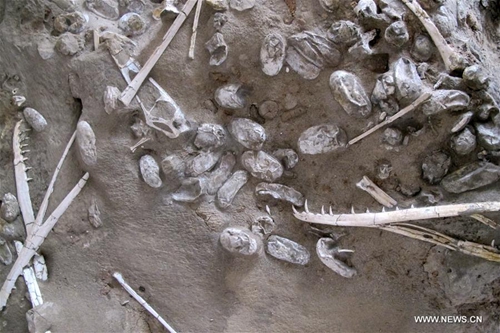
The undated photo shows pterosaurs' eggs, embryos and bones found in a desert in Hami, northwest China's Xinjiang Uygur Autonomous Region. Over 200 three-dimensionally preserved eggs of pterosaurs have been unearthed in China, providing new insight into the life history of the rulers of the skies in the age of dinosaurs, scientists said Nov. 30, 2017. The findings on the pterosaur species, known as Hamipterus tianshanensis, were published in the U.S. journal Science. (Xinhua/Wang Xiaolin)

The undated photo provided by Alexander Kellner shows that paleontologists Wang Xiaolin (R) and Alexander Kellner collect specimens in a desert in Hami, northwest China's Xinjiang Uygur Autonomous Region. Over 200 three-dimensionally preserved eggs of pterosaurs have been unearthed in China, providing new insight into the life history of the rulers of the skies in the age of dinosaurs, scientists said Thursday. The findings on the pterosaur species, known as Hamipterus tianshanensis, were published in the U.S. journal Science. (Xinhua)
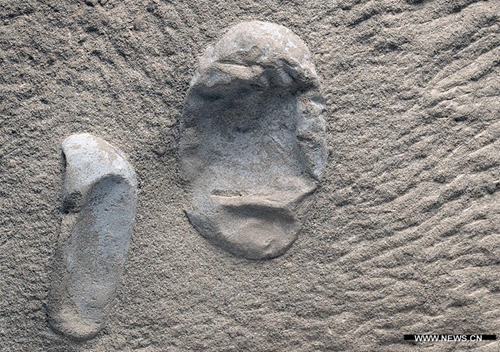
The undated photo shows a pterosaur's egg (R) found in a desert in Hami, northwest China's Xinjiang Uygur Autonomous Region. Over 200 three-dimensionally preserved eggs of pterosaurs have been unearthed in China, providing new insight into the life history of the rulers of the skies in the age of dinosaurs, scientists said Thursday. The findings on the pterosaur species, known as Hamipterus tianshanensis, were published in the U.S. journal Science. (Xinhua/Wang Xiaolin)
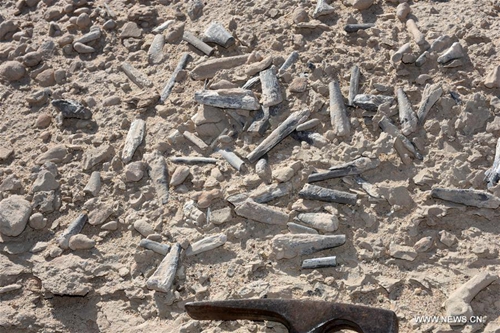
The undated photo shows hundreds of pterosaurs' bones laying on the surface in a desert in Hami, northwest China's Xinjiang Uygur Autonomous Region. Over 200 three-dimensionally preserved eggs of pterosaurs have been unearthed in China, providing new insight into the life history of the rulers of the skies in the age of dinosaurs, scientists said Thursday. The findings on the pterosaur species, known as Hamipterus tianshanensis, were published in the U.S. journal Science. (Xinhua/Alexander Kellner)

The reconstruction image made by Zhao Chuang shows the species Hamipterus tianshanensis according to the discoveries in a desert in Hami, northwest China's Xinjiang Uygur Autonomous Region. Over 200 three-dimensionally preserved eggs of pterosaurs have been unearthed in China, providing new insight into the life history of the rulers of the skies in the age of dinosaurs, scientists said Thursday. The findings on the pterosaur species, known as Hamipterus tianshanensis, were published in the U.S. journal Science. (Xinhua)
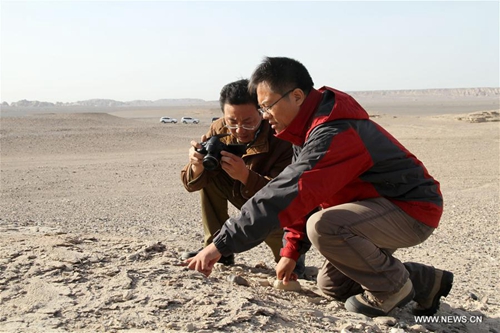
The undated photo provided by Wang Xiaolin shows paleontologists Wang Xiaolin (R) and Zhou Zhonghe work in a desert in Hami, northwest China's Xinjiang Uygur Autonomous Region. Over 200 three-dimensionally preserved eggs of pterosaurs have been unearthed in China, providing new insight into the life history of the rulers of the skies in the age of dinosaurs, scientists said Thursday. The findings on the pterosaur species, known as Hamipterus tianshanensis, were published in the U.S. journal Science. (Xinhua)
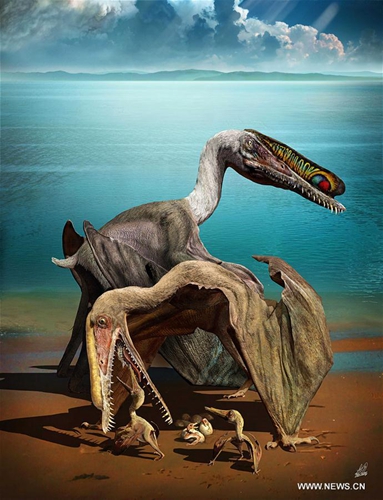
The reconstruction image made by Zhao Chuang shows the species Hamipterus tianshanensis according to the discoveries in a desert in Hami, northwest China's Xinjiang Uygur Autonomous Region. Over 200 three-dimensionally preserved eggs of pterosaurs have been unearthed in China, providing new insight into the life history of the rulers of the skies in the age of dinosaurs, scientists said Thursday. The findings on the pterosaur species, known as Hamipterus tianshanensis, were published in the U.S. journal Science. (Xinhua)
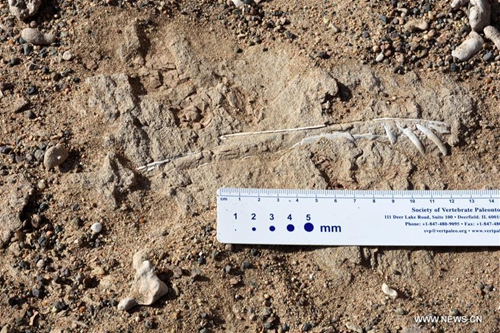
The undated photo shows a pterosaur's lower jaw eroding on the surface in a desert in Hami, northwest China's Xinjiang Uygur Autonomous Region. Over 200 three-dimensionally preserved eggs of pterosaurs have been unearthed in China, providing new insight into the life history of the rulers of the skies in the age of dinosaurs, scientists said Thursday. The findings on the pterosaur species, known as Hamipterus tianshanensis, were published in the U.S. journal Science. (Xinhua/Alexander Kellner)
